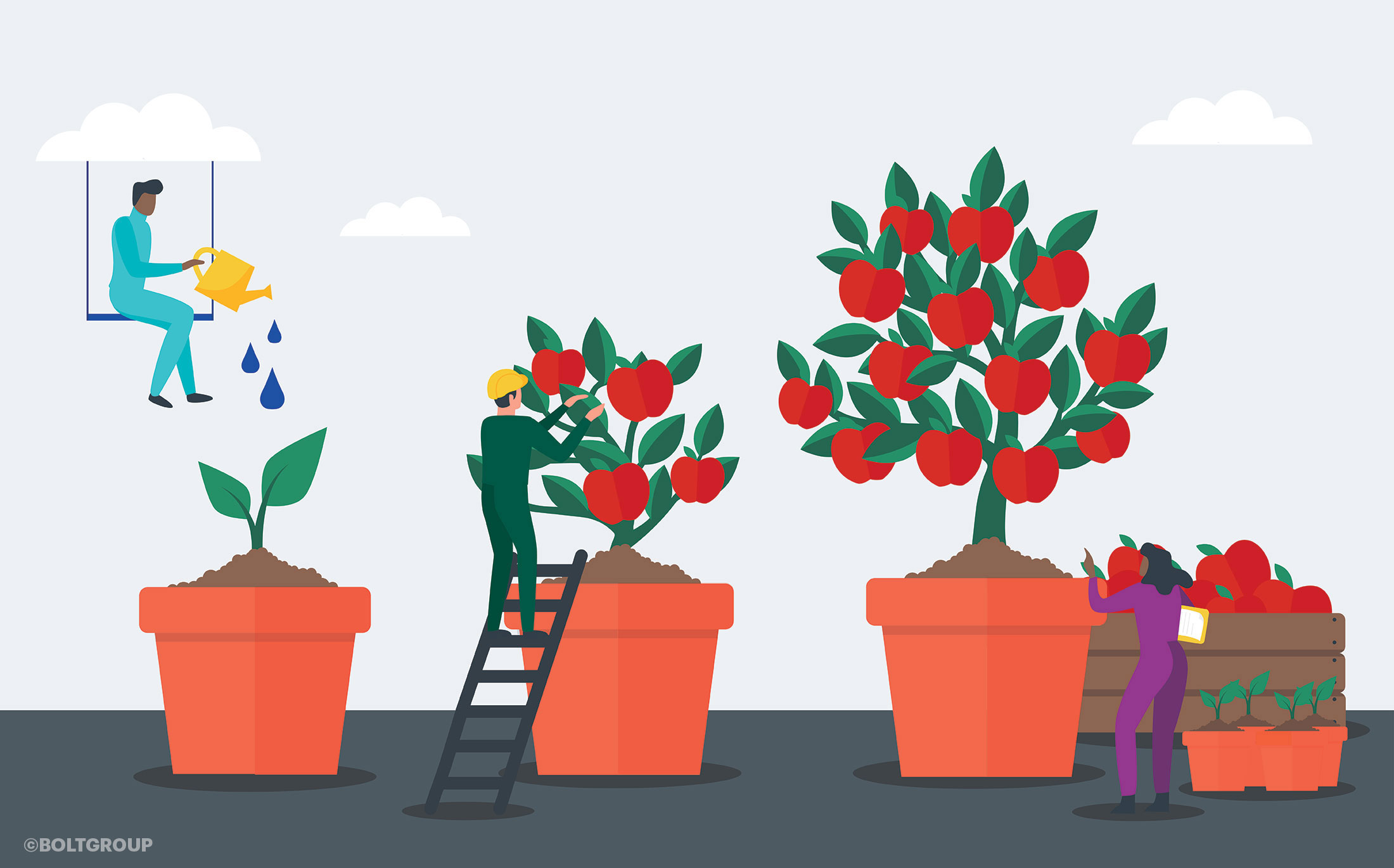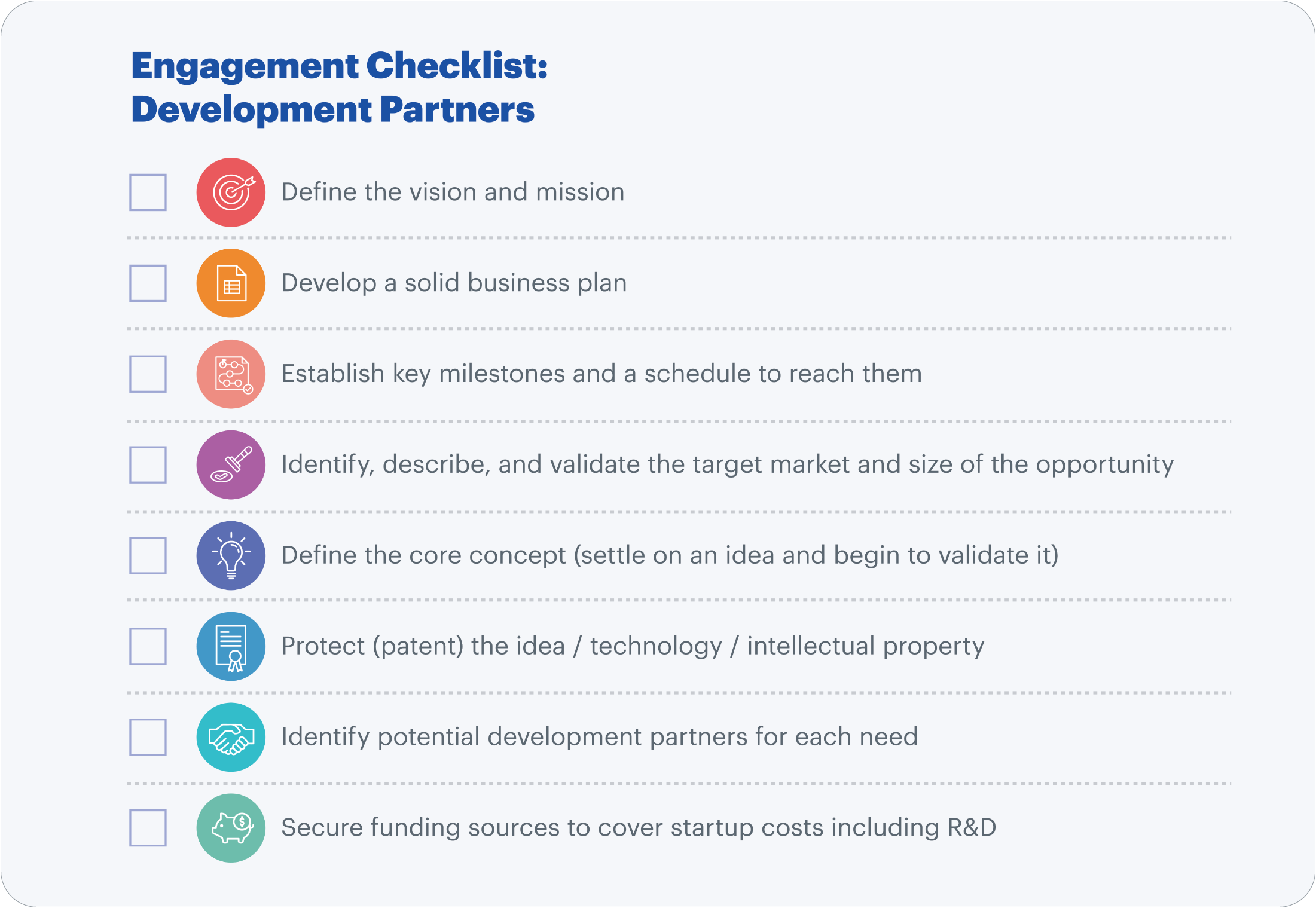Launching a successful startup can be an exciting and rewarding experience. BOLTGROUP looks at ways to maximize your startup’s potential.

October 17th, 2022
The Startup Process: How to Grow an Idea Into a Business
Are you ready to supercharge the development of your idea?
It starts with an idea. A startup is a business venture created to launch an idea. Strip away the app, the widget, the website—at the heart of every startup you will find the idea. It can come from anywhere—a spark of random insight or the culmination of extensive research—but to be a good idea for a startup, it should do two things:
1. Provide a unique solution to a meaningful problem.
2. Have an identifiable market.
In business terms, an “idea” doesn’t have any value until these two things are proven.
“How does the idea work?”
“How much does it cost?”
“Who is going to buy it? And how much will they pay?”
The answers to these questions help you and your investors determine how much “value” the idea has. But you won’t know the answers until you start to develop your idea.
To launch your idea into a startup, you need a plan (and money).
Launching a successful startup can be an exciting and rewarding experience. As the founder, you have the opportunity to realize your vision on your terms. You have a chance to improve people’s lives with your products and services. And with enough determination and a bit of luck, you may grow that startup into a thriving and profitable business. But it doesn’t happen overnight, and it doesn’t happen by accident. To give your startup the best chance of success, you need a plan to develop your idea, and your business.
It could be a physical product, a software app, or a service: in every case, your idea needs to be developed and proven to realize its value. That means research, prototyping, and testing until market fit is established. The development process can be unpredictable and expensive, sometimes requiring multiple rounds of investment and prototyping, before sales revenue can be established and the business can grow.
We have had the good fortune at BOLTGROUP to partner with a number of startups over the years to help them develop their products, brands, services, and campaigns. Many have been successful—but some have not. Informed by these experiences, we present this white paper as a tool to help entrepreneurs (and established businesses with an entrepreneurial spirit) plan the development of an idea into a thriving and successful startup business.
The 3 Stages of a Startup
There are many different paths to startup success, but most go through 3 distinct stages along their journey from idea to thriving business:
1. Early-Stage: define the business plan, product, and brand
2. Mid-Stage: start to sell products and grow the business
3. Late-Stage: diversify the product range and scale the business

One thing that distinguishes the different stages of a startup is where the money comes from. It requires a big investment of time and resources to launch a branded product or service; only very high net-worth individuals or businesses can afford to finance a startup on their own. Most will need investors.
Initially, when a startup is getting off the ground, investment funding may be limited to seed capital (e.g., invested by the founders) and loans from angel investors (often friends and family). As the business progresses through the stages of a startup, building and demonstrating value in the concept, they gain access to more opportunities for investment.
Another thing that distinguishes the different stages of a startup is the role of its leadership. Each stage places a different set of priorities and pressures on the startup business. For that reason, as the startup evolves, so must the roles and responsibilities of the leadership team. Not surprisingly, different types of leaders thrive in different stages of the startup. To learn more about the “personas” of a successful startup, check out our blog: 3 Personality Types Your Startup Needs to Succeed

Early-Stage Startup
In the early stage of a startup, the goals are to define and prove the concept, attract seed funding, and create an MVP (Minimum Viable Product). The founders provide the guiding vision and passion for the idea, driving early development and initial fund raising. Investors at this stage are considered “angel investors”, often friends and family. The risk for investors is very high at this stage because the young startup has a lot to prove. This stage can be long and difficult as founders struggle to gain traction and growth.

Development Partners
The Early Stage is often when startups first engage one or more development partners to augment their internal capabilities. These partners can provide strategic planning, research, brand strategy, product development, engineering, or other design services to help startups on the path to “MVP”. Before you start reaching out to potential partners, first make sure your startup is ready to begin development.
When your startup is ready to begin development, work with your partners to plan the process and methodology, including timelines (key to establishing and managing expectations with stakeholders). The process can vary widely depending on the nature of the product or service being developed, but most startups progress through these key milestones during this stage.
Early-stage
Key Characteristics
- Often founded / led by a “Creator”
- Starts with an idea that has potential to generate value
- “Seed round” investment comes from “angel investors”
- Defines and proves the core concept
- Working towards “MVP”
- Risk for investors at this stage: very high
Major Milestones

Mid-Stage Startup
As the startup attracts investment and establishes sales, they are faced with the next challenge: growth. For startups in the mid-stage, growth comes from two places: sales and additional investment.
It may take multiple rounds of investment and development before a startup can reach its full potential. To appeal to investors, startups need to grow sales with their core market by tweaking and adjusting the formula until they achieve “Market Fit”.
They also need to demonstrate the potential to scale and diversify through continued product development and roadmapping. The risk for potential investors is still high during this stage as the business is only beginning to generate revenue and show its potential.
Startup Case Study:The Burro Buddy
In 2014, we were working with a startup to develop an accessory tray for wheelbarrows. Bob Thorsen, observing his wife in the garden, envisioned a better solution to organize and transport gardening tools and supplies around the yard. He started a business with his family to bring his idea to life.
The Thorsens hoped to market the product, called the Original Little Burro, to two different types of consumers: gardeners and contractors. We designed the product with features that appealed to both user groups. When they launched the product the following year, it generated excitement and awards at retailer trade shows and earned placement at several retail chains. Sales were slow and steady, and feedback from retailers and consumers was mostly positive, especially from home gardeners. But there were some challenges as well. The size and weight, mostly driven by contractor-friendly features, made the product expensive to ship and hard to place at retail. And the contractor market never materialized.
They hadn’t quite established the market fit required for sales to take off, though they had a glimpse of what success might look like. And this is where many entrepreneurs stall out. The R&D path to success is often filled with twists, turns, and speed bumps. But the Thorsens knew they weren’t at the end of the startup journey, but the beginning. So, we went back into the shop, refining and honing the product design and brand strategy based on what we learned.

What emerged was the Burro Buddy, the leaner and lighter cousin to the Original Little Burro. With the Burro Buddy, we retained the features gardeners loved from the original, delivered in a smaller, easier to handle (and merchandise) package. We also refreshed the brand and messaging strategy to focus solely on home gardeners. This time the biggest retailers in the business bought in: the product launched in Lowe’s Home Improvement stores nationwide in 2022 to rave reviews and Walmart has signed on for 2023.
Read the full case study here.
Mid-stage
Key Characteristics
- The primary goal of this stage is to establish and demonstrate market fit
- Business transitions to Builder-led
- “Series A” investment comes from venture capital and/or angel investors
- Additional funding from initial sales revenue
- Starting to grow and show potential
- Focused on KPI measured growth
- Expected to hit milestones
- Risk for investors at this stage: high
Major Milestones

Late-Stage Startup
By this point your startup may be enjoying consistent sales and you should be asking, “what next?”. The worst thing you can do is become complacent: the late-stage is where the greatest potential for growth exists. By diversifying your brand / product / service offering, while scaling up and increasing production quantities, you can dramatically increase your market potential and lower costs. At this stage more traditional investment sources become available, such as private equity firms, growth firms, corporate venture capitalists, etc. This is usually the first point at which founders can successfully exit the business, moving on through sale or IPO.
Late-stage
Key Characteristics
- The primary goal of this stage is to scale up
- Business transitions to Operator led
- Series B, C, D funding
- Increased revenue from sales
- Often the first milestone where a founder may consider exiting
- Risk for investors: medium-high
Major Milestones
Startups and the Business of Ideas
Click here for resources to help your startup develop ideas into a thriving businessOther Key Roles in the Startup Ecosystem
Beyond the roles within your growing organization, there are other important partners to identify. A range of suppliers, consulting agencies, and development firms exist in the larger startup and development ecosystem. It is important to find good partners you trust with relevant experience to help your business navigate the process and maximize chances of success.
In addition to development partners and suppliers, startups must rely on counsel to navigate the complex legal landscape. For an introduction to the key stages of a startup for legal services, check out this resource from Startup Commons.
Development Partner(s)
- Provide technical experience, capability, and bandwidth to complement the core team
- Augments research, design, engineering, brand strategy, marketing, sales, prototyping, manufacturing, distribution
- Should have experience working with startups and entrepreneurs
- May include consulting agencies, design & development firms, universities, incubators/ accelerators, corporate sponsors
Supplier Vendors
- Materials suppliers, fabricators, contract manufacturers, distributors, quality control
Other Consultants and Advisors
- SBE (Small Business Enterprise) & IP legal council
- SBE Banking and CPA services
- Small business mentors
Investors
- Provide funding for development and expansion of the idea / business
- Investors look for a strong founding team, balanced risk / return profile, and scalability
- Investors also want to make sure the idea is unique and protected (patented)
Typical Startup Investor Types:
- Angel / private investors (early-stage)
- Venture capital investors (mid-stage)
- Private equity / corporate VC (late-stage)
Other Funding Sources:
- Crowdfunding platforms
- Loans, grants
- “Bootstrapping” (self-funded)
A Smarter Startup
Launching a startup is a great challenge, and success is never assured, but there is a lot you can do to increase your odds. Start with a solid, well-thought-out idea, backed by a solid plan and the right team. Make sure your core leadership team has complementary and relevant personalities, skills, and experience to grow your startup and develop your idea through each stage. Choose partners that complement your core skills and fill in the gaps to ensure your team has the right Creator – Builder – Operator balance.
To keep your startup on track, your team must understand and plan for the total startup journey and communicate that plan clearly to your investors, partners, and employees, so everyone is equipped to help your startup grow and succeed. Consider which goals and priorities to focus on now and how those priorities must shift as you progress from early-stage, to mid-stage, to late-stage startup. Then, pursue those goals with passion and purpose, ready for the twists and turns ahead.
References and Resources:
Startup roles:
Stages of a startup:
Startup Key Stages for Legal Services:
Early-Stage Startup Checklist reference:
“Startup Company” Wikipedia: